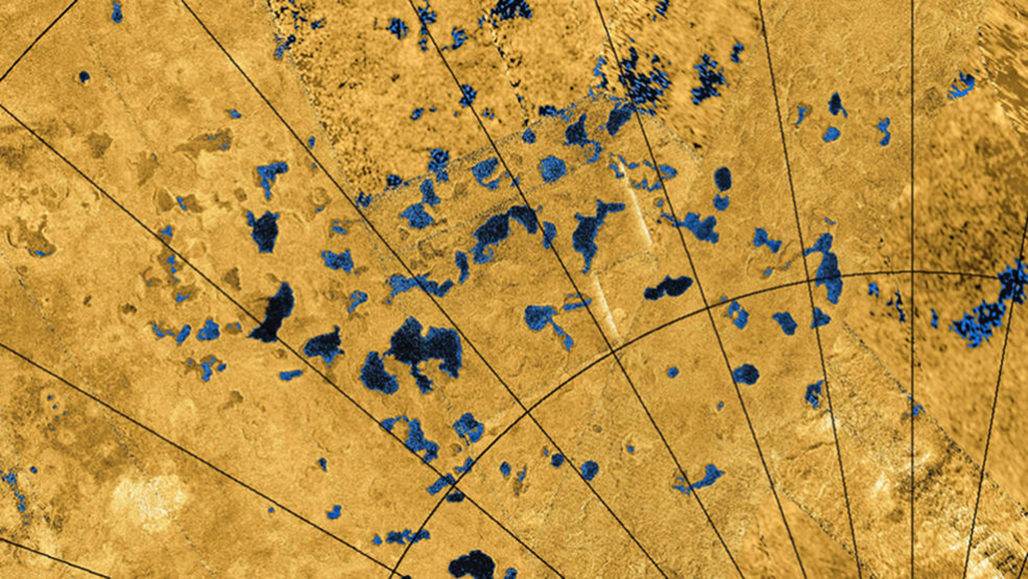Saturn’s moon Titan may host lots of dried lakes
Bright radio signals suggest the lost lakes sit near the satellite’s equator

Titan has hundreds of lakes in its polar regions. They are shown in this radar image from NASA’s Cassini spacecraft. Data also show that dried-up lakes may exist at this moon’s equator.
USGS, ASI, JPL-Caltech/NASA
Saturn’s moon Titan has spots around its midsection. Those spots, scientists say, could be the dried-up floors of ancient lakes and seas. Scientists proposed the explanation June 16 in Nature Communications. If correct, it may solve a 20-year-old mystery.
That mystery first arose in 2000. Astronomers at the time looked at Titan using radio telescopes on Earth. Those telescopes revealed particularly bright radio signals. They were coming from the moon’s equator. Those signals are called specular reflections. They occur when light waves (and radio waves are a type of light) bounce off of a flat surface in a particular way. The waves bounce off at the same angle they went in. It’s like light bouncing off a mirror.
One natural explanation is that Titan has large bodies of liquid near its equator. NASA’s Cassini spacecraft offered some evidence for this. It arrived at Saturn in 2004. And it did show that Titan is speckled with lakes and seas.
“Titan is still currently the only other place in the universe that we know to have liquid on its surface, just like the Earth,” says Jason Hofgartner. He is a planetary scientist at NASA’s Jet Propulsion Laboratory in Pasadena, Calif.
But some features of Titan’s lakes and seas make them unlike those on Earth. Their liquid is not water but ethane and methane. Both are simple hydrocarbons. Those lakes and seas also are concentrated near Titan’s poles. They are not near the equator. The regions where the specular reflections show up are surprisingly dry.

Educators and Parents, Sign Up for The Cheat Sheet
Weekly updates to help you use Science News Explores in the learning environment
Thank you for signing up!
There was a problem signing you up.
To solve the riddle, Hofgartner and his colleagues revisited data from several telescopes. The team looked at radio data from the Arecibo Observatory in Puerto Rico and from the Green Bank Observatory in West Virginia. They also looked at radio data from the Cassini spacecraft. Along the way, they corrected differences in the ways various observations had referred to locations on Titan. After doing that, these researchers realized that the specular reflections all come from a few specific spots.
Next, they considered what might cause them. It could be rainfall, dunes or dry lake beds. But only lake beds would explain the timing and locations of the signals. It does rain on Titan, but not frequently enough to explain the reflections. Titan’s dunes are in the wrong spots. Those specular reflections come only from two specific regions. They resemble other empty lake basins near Titan’s poles.
“I think it’s a compelling argument,” says Zibi Turtle. She is a planetary scientist at Johns Hopkins University’s Applied Physics Laboratory near Baltimore, Md., and was not involved in the new study. “It’s great to have an answer to this outstanding question and one more piece of Titan that we understand better now.”
Turtle is leading work on a space mission due to explore Titan starting in 2034. Called Dragonfly, the mission is being run by NASA. Turtle and her colleagues plan to use it to land a dronelike spacecraft on Titan. Dragonfly is not going to visit the dry lakes region near the moon’s equator. “But there’s always … comparative geology that you can do from one place to another,” she says.
Before then, scientists would like to know where the liquid from the lost lakes went. Hofgartner has some ideas. One possibility is that it migrated to the poles. That could happen as part of a cycle that moves methane around the moon. Another is that the liquid evaporated. Then, it was destroyed by sunlight striking Titan’s atmosphere.
“I wouldn’t be surprised if both were happening,” Hofgartner says.
The new finding could also sound a note of caution. That’s especially true for astronomers who are looking for planets beyond the solar system and that are friendly to life, Hofgartner says. “The lesson is that we have to be very, very strict … when we’re trying to find, say, oceans on other planets,” he says. Evidence of oceans could easily dry up.







